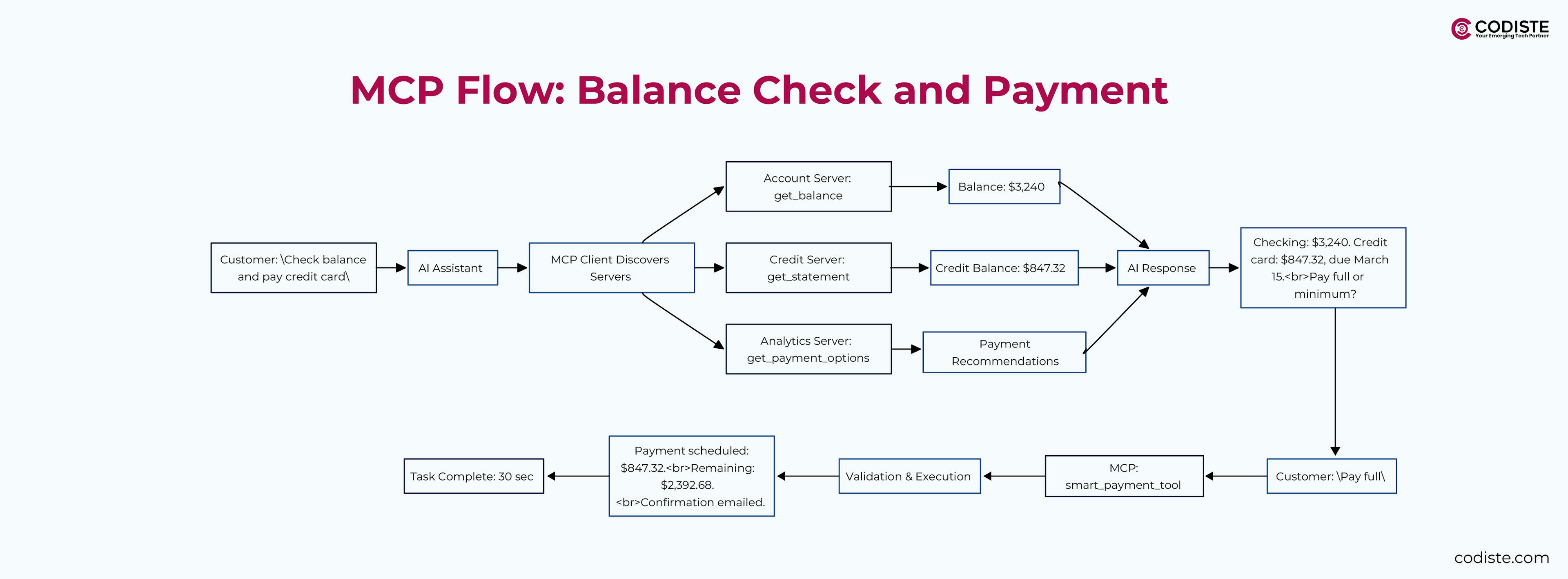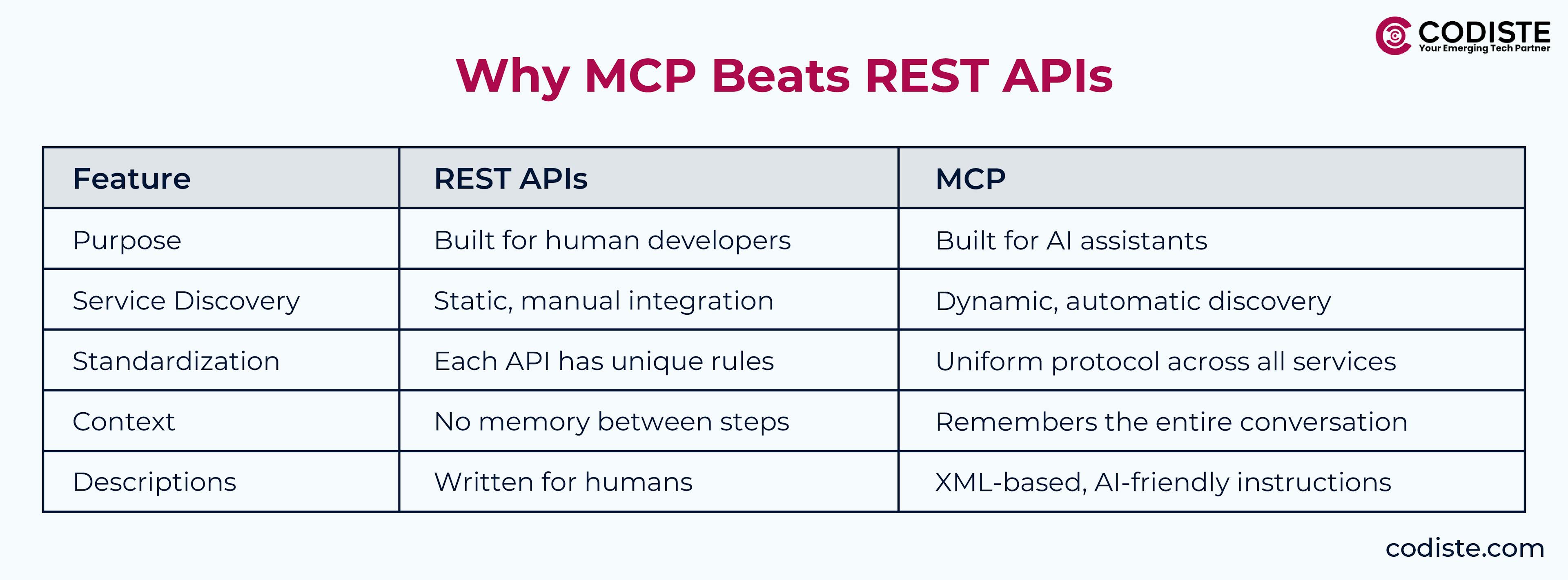
,
Imagine it’s 2 AM, and Alex, a small business owner, is trying to figure out why her loan application was rejected. She’s flipping between her bank’s mobile app, a clunky web portal, and a customer service chat, growing frustrated with every tap. This disjointed experience is all too common in today’s banking world, where outdated technology creates barriers between customers and their financial goals. But a new standard called the Model Context Protocol (MCP) is changing that, promising a future where banking feels like a natural conversation with a smart assistant.
MCP, an open-source protocol developed by Anthropic, is like a universal charger for AI-powered banking. It connects AI systems to financial services seamlessly, making tasks like checking balances, transferring money, or applying for loans faster and more intuitive. In this blog, we’ll explore how MCP is revolutionizing banking, why it’s better than the current REST API systems, and what it means for customers, developers, and the financial industry.
The Problem: Why Current Banking Systems Struggle
Most banks today rely on REST APIs—think of them as the internet’s way of letting apps talk to each other. While REST APIs get the job done, they’re not built for the modern world of AI and instant customer expectations. Let’s look at how NeoBank, a fictional digital bank, operates today:
- Multiple Apps and Portals: Customers like Alex use separate mobile apps, web portals, and ATMs, each requiring different logins and navigation.
- Complex Integrations: Every service (e.g., checking balances, applying for loans) needs its own API connection, creating a web of complexity.
- Human-Focused Design: APIs are designed for developers reading manuals, not for AI systems that need clear, machine-readable instructions.
- Slow and Frustrating: Simple tasks, like paying a credit card bill, involve 15+ steps across multiple screens, taking 3-5 minutes with a 73% success rate.
For Alex, checking her account balance, viewing transaction history, or applying for a loan means navigating a maze of interfaces, entering the same information repeatedly, and often waiting days for responses. For banks, this leads to high customer service costs, slow innovation, and frustrated users.
What is MCP? A Game-Changer for Banking
MCP is like a universal language for AI in banking. Just as USB-C simplified connecting devices, MCP standardizes how AI systems interact with financial services. It’s built to let AI assistants understand customer needs, access the right tools, and complete tasks in one smooth conversation. Here’s how it works:
MCP Architecture in Simple Terms

- AI Banking Assistant (MCP Host): This is the smart AI (like Claude or a custom banking bot) that talks to customers, understands their requests, and coordinates actions.
- MCP Client: A middle layer that connects the AI to banking services, using a standard protocol (JSON-RPC 2.0) to discover what each service can do.
- MCP Servers: These are the bank’s tools for accounts, payments, loans, and analytics, designed specifically for AI to use easily.
Example MCP Tools
Here are some MCP tools that NeoBank could use, written in a format AI understands:
XML
<account_management_tool>
<name>comprehensive_account_overview</name>
<description>
Gives a full picture of a customer’s finances:
- Checking, savings, and credit card balances
- Recent transactions
- Pending payments
- Available credit
Use when someone asks, “How much money do I have?” or wants a financial summary.
</description>
<input_schema>
<customer_id>string</customer_id>
<include_projections>boolean</include_projections>
</input_schema>
</account_management_tool>
<smart_transfer_tool>
<name>intelligent_fund_transfer</name>
<description>
Transfers money with built-in safety checks:
- Verifies account balances
- Suggests the best time to transfer
- Handles currency conversion
- Sends a confirmation with a reference number
Use for moving money between accounts or to others.
</description>
<input_schema>
<from_account>string</from_account>
<to_account>string</to_account>
<amount>number</amount>
<currency>string</currency>
<transfer_date>date</transfer_date>
</input_schema>
</smart_transfer_tool>
<emergency_card_block>
<name>emergency_card_block</name>
<description>
Blocks a lost or stolen card and orders a replacement:
- Instantly freezes the card
- Sends SMS/email confirmation
- Ships a new card within 24 hours
- Offers a temporary digital card
- Monitors for suspicious activity
Use when a customer says, “I lost my card” or reports suspicious transactions.
</description>
<input_schema>
<customer_id>string</customer_id>
<card_id>string</card_id>
</input_schema>
</emergency_card_block>
How MCP Transforms the Customer Experience
With MCP, Alex’s banking becomes a breeze. Instead of juggling apps, she talks to an AI assistant that handles everything in one go. Here’s how it looks:
Paying a Credit Card Bill
Today (REST APIs):
- Alex opens the mobile app, navigates to accounts, checks her balance ($3,240), goes to the credit card section,sees her balance ($847.32), navigates to payments, enters details, and confirms. It takes 3-5 minutes and 15+ taps.
With MCP:
- Alex says, “Check my balance and pay my credit card.”
- The AI responds, “You have $3,240 in checking. Your credit card balance is $847.32, due March 15. Pay the full amount or minimum?”
- Alex says, “Full amount.”
- The AI confirms, “Payment of $847.32 scheduled for March 15. You’ll have $2,392.68 left. Confirmation emailed.”
- Total time: 30 seconds, one conversation.
Applying for a Loan
Today (REST APIs):
- Alex visits the web portal, reads requirements, downloads forms, gathers documents, uploads them, and waits 3-7 days for a response, often needing to resubmit or call support.
With MCP:
- Alex says, “I need $50K to expand my café.”
- The AI replies, “Based on your $45K monthly revenue and credit score, you’re pre-qualified for $50K at 5.2% APR. I need tax returns, bank statements, and a business license. Shall I start?”
- Alex agrees, uploads documents via the AI, which uses OCR to process them instantly.
- The AI says, “Application ready. Terms: $50K at 5.2%, 60 months. Submit now?”
- Alex says, “Submit.”
- The AI confirms, “Loan approved! Funds available in 2 hours. Reference: #LN789456.”
- Total time: 15 minutes, one conversation.
This boosts task completion rates from 73% to 94% and cuts the Customer Effort Score from 4.2 to 2.1 on a 5-point scale.
Start Building Secure, Decentralized Apps with MCP.
Discover how the Modular Communication Protocol works for your Blockchain Platform
Visualizing the Change: Flow Diagrams
To see MCP’s impact, let’s compare how tasks flow with REST APIs vs. MCP.
Current REST API Flow: Balance Check and Payment

MCP Flow: Balance Check and Payment

Loan Application Flow
REST API Flow (3-7 days):
- Alex navigates the web portal, downloads forms, gathers documents, uploads them, waits for manual review, and possibly resubmits. It’s a 20+ step process with multiple touchpoints.
MCP Flow (15 minutes):

Why MCP Beats REST APIs
Here’s how MCP compares to REST APIs:

Benefits for Banks
- Faster Service: Loan approvals drop from days to hours; account openings take 3 minutes instead of 20.
- Happier Customers: 180% better cross-selling (e.g., suggesting loans based on spending) and fewer complaints.
- Lower Costs: 60% fewer customer service calls as AI handles most tasks.
- Easier Innovation: New features launch in weeks, not months, thanks to MCP’s standard format.
Building MCP: Challenges and Solutions
Switching to MCP isn’t just about flipping a switch. Banks like NeoBank face hurdles when moving from REST APIs to MCP, but there are smart ways to tackle them.
The Trap of Auto-Generation
Some tools (e.g., Mintlify, Stainless) can automatically turn REST APIs into MCP servers, but they often create problems:
- Too Many Tools: Converting NeoBank’s 75+ API endpoints into MCP tools overwhelms AI assistants, leading to errors.
- Bad Descriptions: API docs are written for humans, not AI, so the AI picks the wrong tools.
- Wrong Focus: APIs focus on low-level tasks (e.g., “get account data”), not customer goals (e.g., “send money to a friend”).
How to Build MCP Right
- Start with Auto-Generation: Use tools to create a rough MCP server from existing APIs.
- Simplify: Cut down to 8-12 tools focused on customer needs, like apply_for_loan or block_lost_card.
- Write for AI: Create clear, XML-based descriptions that tell AI when and how to use each tool.
- Add Smart Workflows: Build multi-step processes, like loan applications, that guide the AI through validation and approval.
- Test Thoroughly: Check that the AI picks the right tools 95% of the time and follows safety rules 100%.
Sample MCP Loan Workflow
Here’s how NeoBank could build an MCP tool for loans, showing the shift from multiple API calls to a single, smart workflow:
<advanced_loan_processing>
<prepare_loan_application>
<description>
Stages a loan application:
- Checks eligibility in real-time
- Processes documents with OCR
- Creates a secure staging area
- Shows personalized loan terms
- Guides the AI on next steps
</description>
<workflow>
<step>Create temporary processing branch</step>
<step>Validate application completeness</step>
<step>Run preliminary credit checks</step>
<step>Generate personalized terms</step>
<step>Provide feedback to AI</step>
</workflow>
</prepare_loan_application>
<complete_loan_application>
<description>
Finalizes the application:
- Reviews all checks
- Submits to main processing
- Starts automated underwriting
- Sets up status notifications
- Gives a tracking number
</description>
</complete_loan_application>
</advanced_loan_processing>
Keeping It Safe and Reliable
Banking is serious business, so MCP tools are designed with safety in mind:
- Validation Checks: Every tool, like intelligent_fund_transfer, verifies balances and limits before acting.
- Confirmation Steps: Customers get a preview (e.g., “Pay $847.32?”) before any action is finalized.
- Audit Trails: Every transaction is logged to meet regulations and ensure transparency.
- Testing: Banks test MCP tools to ensure the AI picks the right one (95% accuracy) and completes workflows without errors (90% success).
The Big Picture: Why MCP Matters
MCP isn’t just a tech upgrade—it’s a whole new way of banking. Big names like Microsoft, Google, and OpenAI are already using MCP, and banks are jumping on board. Here’s what it means:
- For Customers: Banking becomes as easy as chatting with a friend. Alex’s 2 AM loan struggle turns into a 15-minute approval.
- For Developers: MCP’s standard format makes it easier to build and integrate new features.
- For Banks: Faster innovation, lower costs, and happier customers give a competitive edge.
- For the Industry: MCP opens the door to partnerships with fintechs, creating a connected ecosystem.
The Core of Trustworthy, Decentralized Communication is Here.
Start integrating a secure digital infrastructure that allows developers and users to create, deploy, and interact with dApps.
What’s Next for MCP in Banking
MCP is young—just six months old—but it’s gaining steam fast. In the future, expect:
- Smarter Assistants: AI will offer personalized advice, like budgeting tips or investment options, based on your financial habits.
- Seamless Integration: New banking services will plug into MCP like apps on a smartphone.
- Global Adoption: More banks and fintechs will adopt MCP, making banking consistent worldwide.
Conclusion: Banking That Feels Like Magic
MCP is turning banking into something simple, fast, and intuitive. Instead of wrestling with apps and forms, customers like Alex can say, “I need a loan,” and have funds in hours. For banks, it means lower costs, quicker innovation, and delighted customers. Whether you’re a developer building the next banking app, a product manager dreaming up new features, or just someone who banks, MCP is making finance smarter and more human.
The future of banking is here, and it’s conversational. With MCP, that future is closer than you think.




